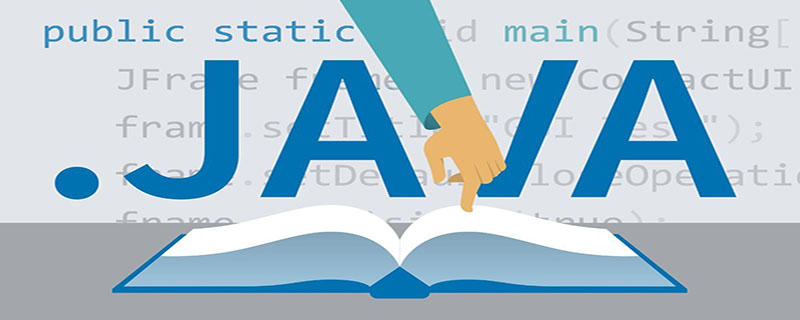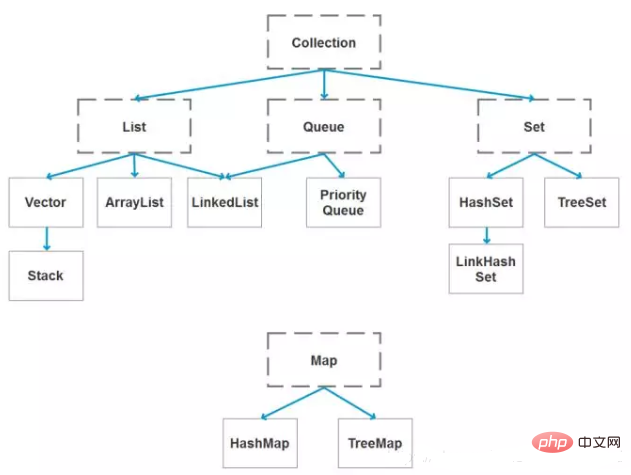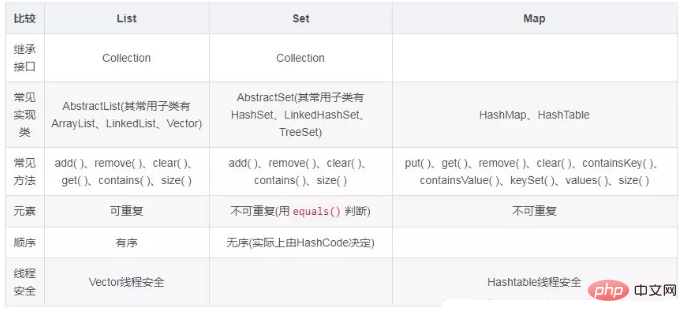Common interview questions about java containers

#What are the Java containers? (Recommended learning: java Frequently see test questions )

# What is the difference between?
java.util.Collection is a collection interface (a top-level interface for collection classes). It provides common interface methods for basic operations on collection objects. The Collection interface has many specific implementations in the Java class library.
The significance of the Collection interface is to provide a maximized unified operation method for various specific collections. Its directly inherited interfaces include List and Set.
Collections is a tool class/helper class of the collection class, which provides a series of static methods for various operations such as sorting, searching, and thread safety of elements in the collection
What is the difference between List, Set and Map?

What is the difference between HashMap and Hashtable?
hashMap removes the contains method of HashTable, but adds containsValue() and containsKey() methods.
HashTable is synchronous, while HashMap is asynchronous, and is more efficient than hashTable.
HashMap allows empty key values, but hashTable does not.
How to decide whether to use HashMap or TreeMap?
HashMap is the best choice for operations such as inserting, deleting and positioning elements in Map. However, if you need to iterate over an ordered collection of keys, TreeMap is a better choice. Depending on the size of your collection, it may be faster to add elements to a HashMap and replace the map with a TreeMap for ordered key traversal.
Tell me about the implementation principle of HashMap?
HashMap Overview: HashMap is an asynchronous implementation of the Map interface based on hash tables. This implementation provides all optional mapping operations and allows null values and null keys. This class does not guarantee the order of the mapping, and in particular it does not guarantee that the order is immutable.
HashMap data structure: In the Java programming language, there are two most basic structures, one is an array, and the other is a simulated pointer (reference). All data structures can use these two basic structures. To construct, HashMap is no exception. HashMap is actually a "linked list hash" data structure, which is a combination of an array and a linked list.
When we put an element into the Hashmap, we first recalculate the hash value based on the hashcode of the key, and get the position (subscript) of the element in the array based on the hash value. If the array is already stored at that position If other elements are added, the elements at this position will be stored in the form of a linked list, with the newly added ones placed at the head of the chain, and the first added elements placed at the end of the chain. If there is no element at this position in the array, the element will be placed directly into the linked list. at that position in the array.
It should be noted that the implementation of HashMap has been optimized in Jdk 1.8. When the node data in the linked list exceeds eight, the linked list will be converted into a red-black tree to improve query efficiency, from the original O(n) To O(logn)
, talk about the implementation principle of HashSet?
The bottom layer of HashSet is implemented by HashMap
The value of HashSet is stored in the key of HashMap
The value of HashMap is unified as PRESENT
What is the difference between ArrayList and LinkedList?
The most obvious difference is that the underlying data structure of ArrrayList is an array and supports random access, while the underlying data structure of LinkedList is a two-way circular linked list and does not support random access. To access an element using a subscript, the time complexity of ArrayList is O(1), while that of LinkedList is O(n).
How to convert between array and List?
Convert List to array: call the toArray method of ArrayList.
Convert an array into a List: call the asList method of Arrays.
What is the difference between ArrayList and Vector?
Vector is synchronized, but ArrayList is not. However, if you seek to make changes to the list while iterating, you should use CopyOnWriteArrayList.
ArrayList is faster than Vector. It will not be overloaded because of synchronization.
ArrayList is more versatile because we can easily obtain synchronized lists and read-only lists using the Collections tool class.
What is the difference between Array and ArrayList?
Array can hold basic types and objects, while ArrayList can only hold objects.
Array is immutable after specifying the size, while the size of ArrayList is variable.
Array does not provide as many functions as ArrayList, such as addAll, removeAll and iterator.
What is the difference between poll() and remove() in Queue?
poll() and remove() both take out an element from the queue, but poll() will return null when it fails to obtain the element, but remove() will throw an exception when it fails. .
Which collection classes are thread-safe?
vector: It has one more synchronization mechanism (thread safety) than arraylist. Because of its low efficiency, its use is no longer recommended. In web applications, especially front-end pages, efficiency (page response speed) is often a priority.
statck: stack class, first in, last out.
hashtable: It is more thread-safe than hashmap.
enumeration: Enumeration, equivalent to iterator.
Iterator What is Iterator?
An iterator is a design pattern that is an object that can be traversed and selected in a sequence without the developer needing to know the underlying structure of the sequence. Iterators are often called "lightweight" objects because they are cheap to create.
How to use Iterator? What are the characteristics?
The Iterator function in Java is relatively simple and can only move in one direction:
(1) Use the iterator() method to require the container to return an Iterator. The first time the Iterator's next() method is called, it returns the first element of the sequence. Note: the iterator() method is the java.lang.Iterable interface and is inherited by Collection.
(2) Use next() to get the next element in the sequence.
(3) Use hasNext() to check whether there are still elements in the sequence.
(4) Use remove() to delete the element newly returned by the iterator.
Iterator is the simplest implementation of Java iterator. ListIterator designed for List has more functions. It can traverse List in two directions and can also insert and delete elements from List.
What is the difference between Iterator and ListIterator?
Iterator can be used to traverse Set and List collections, but ListIterator can only be used to traverse List.
Iterator can only traverse a collection forward, while ListIterator can traverse both forward and backward.
ListIterator implements the Iterator interface and includes other functions, such as: adding elements, replacing elements, getting the index of the previous and next elements, etc.
The above is the detailed content of Common interview questions about java containers. For more information, please follow other related articles on the PHP Chinese website!

Hot AI Tools

Undresser.AI Undress
AI-powered app for creating realistic nude photos

AI Clothes Remover
Online AI tool for removing clothes from photos.

Undress AI Tool
Undress images for free

Clothoff.io
AI clothes remover

Video Face Swap
Swap faces in any video effortlessly with our completely free AI face swap tool!

Hot Article

Hot Tools

Notepad++7.3.1
Easy-to-use and free code editor

SublimeText3 Chinese version
Chinese version, very easy to use

Zend Studio 13.0.1
Powerful PHP integrated development environment

Dreamweaver CS6
Visual web development tools

SublimeText3 Mac version
God-level code editing software (SublimeText3)

Hot Topics
 Break or return from Java 8 stream forEach?
Feb 07, 2025 pm 12:09 PM
Break or return from Java 8 stream forEach?
Feb 07, 2025 pm 12:09 PM
Java 8 introduces the Stream API, providing a powerful and expressive way to process data collections. However, a common question when using Stream is: How to break or return from a forEach operation? Traditional loops allow for early interruption or return, but Stream's forEach method does not directly support this method. This article will explain the reasons and explore alternative methods for implementing premature termination in Stream processing systems. Further reading: Java Stream API improvements Understand Stream forEach The forEach method is a terminal operation that performs one operation on each element in the Stream. Its design intention is
 PHP: A Key Language for Web Development
Apr 13, 2025 am 12:08 AM
PHP: A Key Language for Web Development
Apr 13, 2025 am 12:08 AM
PHP is a scripting language widely used on the server side, especially suitable for web development. 1.PHP can embed HTML, process HTTP requests and responses, and supports a variety of databases. 2.PHP is used to generate dynamic web content, process form data, access databases, etc., with strong community support and open source resources. 3. PHP is an interpreted language, and the execution process includes lexical analysis, grammatical analysis, compilation and execution. 4.PHP can be combined with MySQL for advanced applications such as user registration systems. 5. When debugging PHP, you can use functions such as error_reporting() and var_dump(). 6. Optimize PHP code to use caching mechanisms, optimize database queries and use built-in functions. 7
 PHP vs. Python: Understanding the Differences
Apr 11, 2025 am 12:15 AM
PHP vs. Python: Understanding the Differences
Apr 11, 2025 am 12:15 AM
PHP and Python each have their own advantages, and the choice should be based on project requirements. 1.PHP is suitable for web development, with simple syntax and high execution efficiency. 2. Python is suitable for data science and machine learning, with concise syntax and rich libraries.
 PHP vs. Other Languages: A Comparison
Apr 13, 2025 am 12:19 AM
PHP vs. Other Languages: A Comparison
Apr 13, 2025 am 12:19 AM
PHP is suitable for web development, especially in rapid development and processing dynamic content, but is not good at data science and enterprise-level applications. Compared with Python, PHP has more advantages in web development, but is not as good as Python in the field of data science; compared with Java, PHP performs worse in enterprise-level applications, but is more flexible in web development; compared with JavaScript, PHP is more concise in back-end development, but is not as good as JavaScript in front-end development.
 PHP vs. Python: Core Features and Functionality
Apr 13, 2025 am 12:16 AM
PHP vs. Python: Core Features and Functionality
Apr 13, 2025 am 12:16 AM
PHP and Python each have their own advantages and are suitable for different scenarios. 1.PHP is suitable for web development and provides built-in web servers and rich function libraries. 2. Python is suitable for data science and machine learning, with concise syntax and a powerful standard library. When choosing, it should be decided based on project requirements.
 Java Program to Find the Volume of Capsule
Feb 07, 2025 am 11:37 AM
Java Program to Find the Volume of Capsule
Feb 07, 2025 am 11:37 AM
Capsules are three-dimensional geometric figures, composed of a cylinder and a hemisphere at both ends. The volume of the capsule can be calculated by adding the volume of the cylinder and the volume of the hemisphere at both ends. This tutorial will discuss how to calculate the volume of a given capsule in Java using different methods. Capsule volume formula The formula for capsule volume is as follows: Capsule volume = Cylindrical volume Volume Two hemisphere volume in, r: The radius of the hemisphere. h: The height of the cylinder (excluding the hemisphere). Example 1 enter Radius = 5 units Height = 10 units Output Volume = 1570.8 cubic units explain Calculate volume using formula: Volume = π × r2 × h (4
 PHP: The Foundation of Many Websites
Apr 13, 2025 am 12:07 AM
PHP: The Foundation of Many Websites
Apr 13, 2025 am 12:07 AM
The reasons why PHP is the preferred technology stack for many websites include its ease of use, strong community support, and widespread use. 1) Easy to learn and use, suitable for beginners. 2) Have a huge developer community and rich resources. 3) Widely used in WordPress, Drupal and other platforms. 4) Integrate tightly with web servers to simplify development deployment.
 PHP's Impact: Web Development and Beyond
Apr 18, 2025 am 12:10 AM
PHP's Impact: Web Development and Beyond
Apr 18, 2025 am 12:10 AM
PHPhassignificantlyimpactedwebdevelopmentandextendsbeyondit.1)ItpowersmajorplatformslikeWordPressandexcelsindatabaseinteractions.2)PHP'sadaptabilityallowsittoscaleforlargeapplicationsusingframeworkslikeLaravel.3)Beyondweb,PHPisusedincommand-linescrip






